|
|
Introduction
I decided to write the following information to answer some frequently
asked questions about technical terms related to cels.
Please, note that I never worked in an anime studio and that I pieced
together some information, especialy those concerning douga and
genga based on discussion I had with several people. I don't
promise that they are wholy accurate :)
|
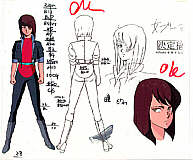
Sample showing the "black lines"

Back of the cel

Front of the cel
|
|
What's a cel ?
Cels (or celluloid) are painting on transparent plastic sheet
used to create an animation. Each cel is one "frame". They are filmed
and then put behind one another to give the illusion of a continuous
motion.
How cels are created ?
There are many steps involved in the creation of an anime but I will
just explain how cels themselves are created.
First, a pencil drawing of the picture is made and "xeroxed" on
a plastic sheet. I say "xeroxed" because it's the company Xerox
that invented that method. In reality, it's a kind of photocopier
or laser printer using photoconductivity to lay a powdered
ink over the plastic sheet.
Finally the cels are painted. It's done from the back of the
plastic sheet, like those stickers you put inside of your
windows to be looked at from the outside.
Usually, when painting cels, the first step is to paint one colour
on all the cels from a sequence. Then, when finished,
the paint on the first cel has had the time to dry and is ready
for the next colour.
|
|

Key cel (A1) from the opening
|
|
What's a key cel ?
Each parts of an animation is broken down in many sequences, each
representing a single action. In a sequence, some cels drawings
are made by "key animators" while the rest is filled in by "normal"
animators. Cels made by "key animators" are called "key cels".
How to recognize a key cel ?
"Key animators" draw the important "frames" of a sequence : The
first frame, the last one and usually one or several middle frames.
Each cel has a code written on it, composed of one letter followed
by a number. The letter represents the layer of the cel. The number
is the position of the cel in the sequence. The first cel has
the number "1". The last cel can have any number (sometime even
"1" for a sequence composed of a single cel) but is written "end"
next to it. Those are "key cels".
Based on an information from Stephen (blame him :), key cels
have their sequence number "circled" on the pencil drawing. (and
sometime on the cel itself)
Example :
A cel written "A1" is the first one of the sequence.
A cel written "B34 end" is the 34th cel of the sequence and the
last one. The "B" usually mean that it's the second layer of
a multi-layer cel.
|
|
|
|
Why key cels are generally more valuable ?
Because "key animators" are more renowned than normal animators. Also,
as they have more experience, the drawings are often of better
quality. It is said, that only animators with 10 years of experience
are allowed to draw "key cel".
But I personally don't agree with that : Often, because of the
position of the characters, the first and last cels of a
sequence won't be the nicest one, even if they may be technically
better...
|
|
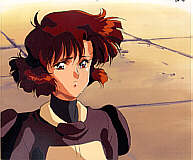
Multi-layers cel (A6/B4)
|
|
What's a multi-layers cel ?
Some cels are composed of several plastic sheet (layers), each
painted with one part of the whole picture. This is often used
for group shot where each character is painted on a different
layer. The reason is that you can animate one character by
painting a new layer without having to re-paint the entire group.
Often, especially for close-ups, the mouth, eyes and hairs of a
character are also painted on a separate layer than the
rest of the face. You can then "make the character talk" by
painting just his mouth without re-painting the whole
picture.
|
|
|
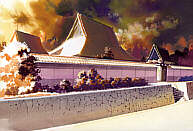 |
|
What about background/foreground ?
Background and foreground are usually watercolour on cardboard.
Often, they are done by separate companies than the cels.
Why don't we see many cels with background ?
A whole scene may have the same background. That means that
there are much more cels than backgrounds.
|
|

Sketch showing the sequence
(draft)

Genga (?)
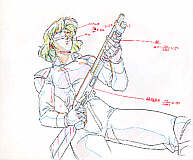
Matching drawing (douga) |
|
What's a genga ?
Genga are drawing of important scenes made by senior animators.
They are then used as model by other animators to draw douga. A genga
is never used directly to make a cel and is usually not available
for sale.
It's also possible to find drafts of genga (rough sketch) but
usually they are not available on the market.
Genga and their drafts are much more valuable than douga.
What's a douga ?
Douga are the "usual" drawing that comes with many cels when
you buy them. They are used to make the cels.
Are cels always sold with their matching drawing (douga) ?
No, not always. It all depends of the studio that produced
the anime. For example, AIC decided, a few years ago, to never
sell their cels with the matching drawing.
|
|
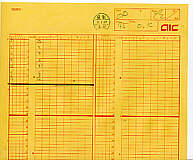 |
|
What's a timechart ?
A timechart contains information about the position of a
cel in the sequence and in the anime. They may also include
information about who painted the cel.
|
|
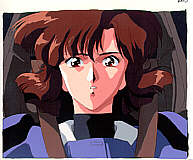 |
|
Why is a cel more expensive than another ?
That's a difficult question : There is both technical
and subjective criteria that define the value of a
cel. Also some anime are more popular or rarer than others
and so more expensive.
Technically, a cel is more expensive if it's a close-up,
if the character has both eyes open and if he/she is
from the front, centered on the plastic sheet.
Subjectively, a cel will be more expensive if the
character has a nice expression, if it looks good...
|
|
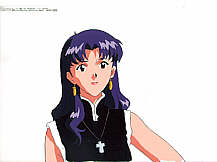
Evangelion reproduction |
|
What's a seri-cel (promotional cel) ?
A seri-cel is like a normal cel (hand-painted over a plastic
sheet) but was created for promotional purpose or to be sold.
They are limited edition and are not used in the production
of the anime.
|
|

Evangelion laser copy |
|
What's a machine made cel (laser copy) ?
Machine made cels (or laser copy) are more similar to laminated
cards than to real cels. They are not hand-painted but printed
with a machine over a transparent plastic sheet.
|
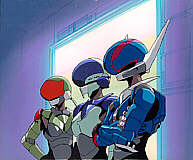

 |
|
What's a chroma-cel ?
Chroma-cel is a trademark. They are similar to laser copies
but use other techniques. They may be limited editions (I am
not interested enough to check :)
Contrary to promotional cels, they aren't
hand-painted and as many copies of them can be printed.
How to store cels ?
The black lines of a cel are very sensitive to bright light
and especially to UV. For that reason, it's very important
to keep them out of sunlight. When storing them, you can
use office binders.
Also, you shouldn't stack too many cels or put something
heavy over them : that's bad for the paint.
Never put a cel directly over another one without putting
at least a piece of paper between : the paint was designed
to stick to the plastic sheet so both cels will get
stuck and usually they can't be separated again without
damaging the top one. For that reason, you should never
try to separate the various layers of a cel.
How to frame cels ?
Once again, the important thing is to avoid UV. For that
reason you should get anti-UV glass. Not all types of
anti-UV glasses filter the same amount of UV. Also many
are not fully transparent and will give
a slight green or yellow hue to the cel. So check before
if that bother you or not.
There is also some spray that can be used to give an
anti-UV coating to a normal glass. It's cheaper but
less effective than buying special glass.
Even if you got anti-UV glass, never ever put the cel
under direct sunlight !
What if the pencil drawing is stuck to the cel ?
If it isn't stuck too much, you can try to remove it
very carefully. But if it's too hard, just let it be
or cut the paper : Better to damage the drawing
than the cel !
|


 Write us !
Write us !